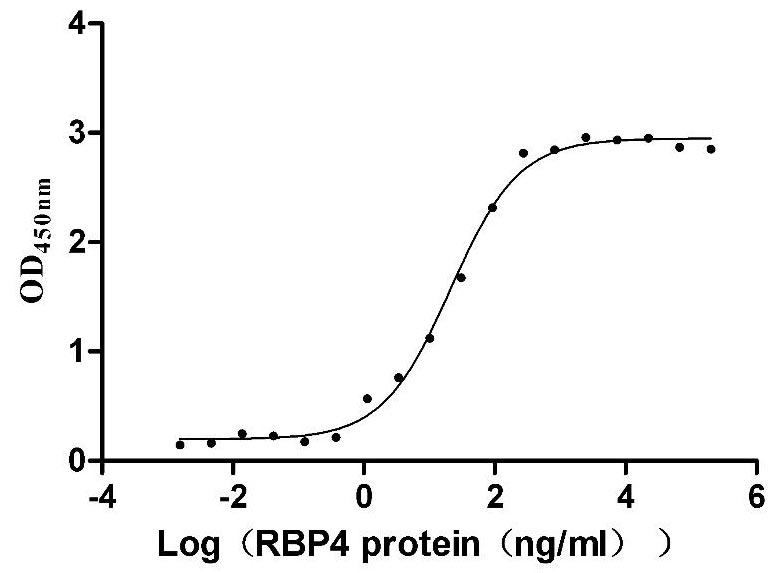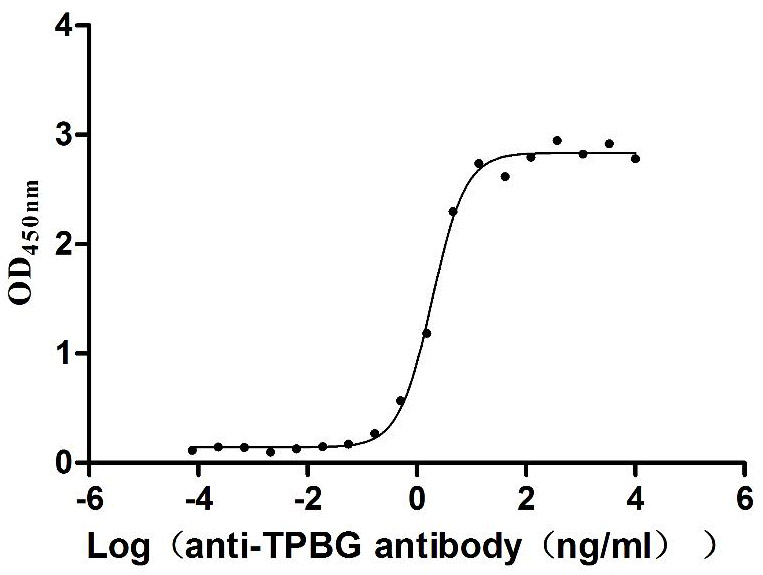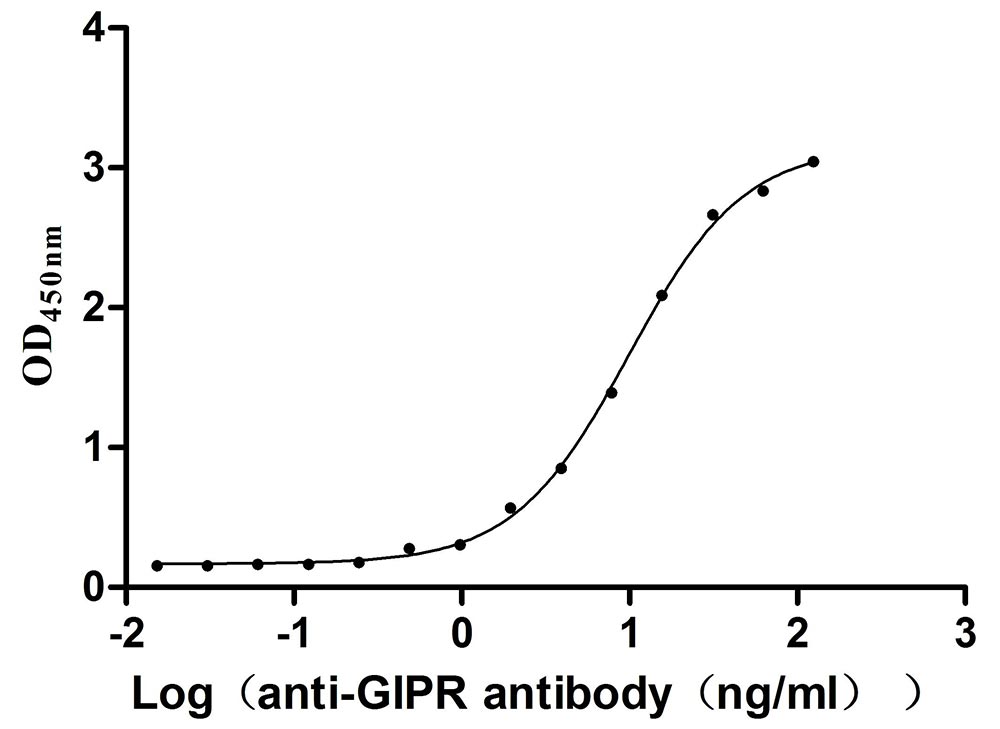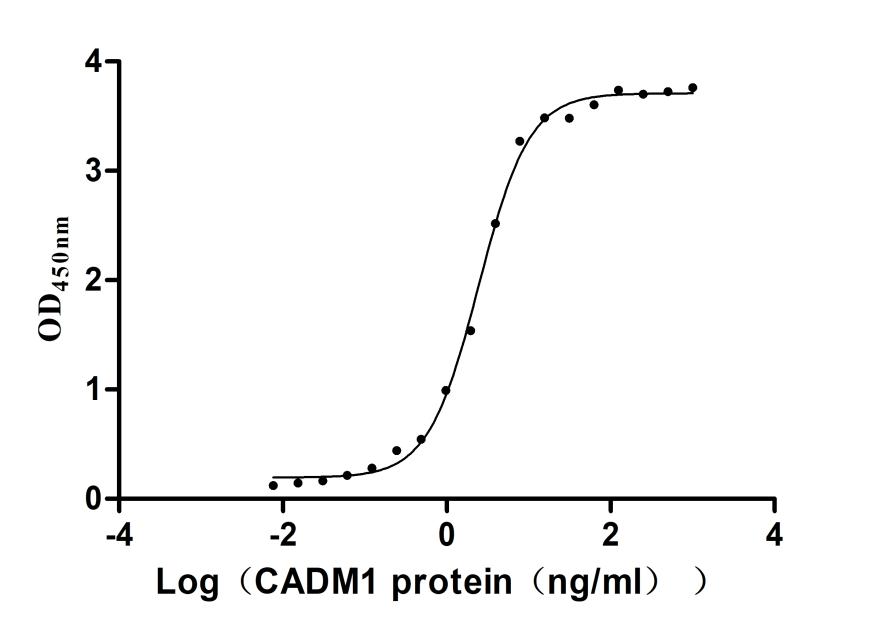Recombinant Mouse Period circadian protein homolog 1 (Per1), partial
-
中文名稱:小鼠Per1重組蛋白
-
貨號(hào):CSB-YP017786MO
-
規(guī)格:
-
來源:Yeast
-
其他:
-
中文名稱:小鼠Per1重組蛋白
-
貨號(hào):CSB-EP017786MO
-
規(guī)格:
-
來源:E.coli
-
其他:
-
中文名稱:小鼠Per1重組蛋白
-
貨號(hào):CSB-EP017786MO-B
-
規(guī)格:
-
來源:E.coli
-
共軛:Avi-tag Biotinylated
E. coli biotin ligase (BirA) is highly specific in covalently attaching biotin to the 15 amino acid AviTag peptide. This recombinant protein was biotinylated in vivo by AviTag-BirA technology, which method is BriA catalyzes amide linkage between the biotin and the specific lysine of the AviTag.
-
其他:
-
中文名稱:小鼠Per1重組蛋白
-
貨號(hào):CSB-BP017786MO
-
規(guī)格:
-
來源:Baculovirus
-
其他:
-
中文名稱:小鼠Per1重組蛋白
-
貨號(hào):CSB-MP017786MO
-
規(guī)格:
-
來源:Mammalian cell
-
其他:
產(chǎn)品詳情
-
純度:>85% (SDS-PAGE)
-
基因名:Per1
-
Uniprot No.:
-
別名:Per1; Per; Rigui; Period circadian protein homolog 1; mPER1; Circadian clock protein PERIOD 1; Circadian pacemaker protein Rigui
-
種屬:Mus musculus (Mouse)
-
蛋白長(zhǎng)度:Partial
-
蛋白標(biāo)簽:Tag?type?will?be?determined?during?the?manufacturing?process.
The tag type will be determined during production process. If you have specified tag type, please tell us and we will develop the specified tag preferentially. -
產(chǎn)品提供形式:Lyophilized powder
Note: We will preferentially ship the format that we have in stock, however, if you have any special requirement for the format, please remark your requirement when placing the order, we will prepare according to your demand. -
復(fù)溶:We recommend that this vial be briefly centrifuged prior to opening to bring the contents to the bottom. Please reconstitute protein in deionized sterile water to a concentration of 0.1-1.0 mg/mL.We recommend to add 5-50% of glycerol (final concentration) and aliquot for long-term storage at -20℃/-80℃. Our default final concentration of glycerol is 50%. Customers could use it as reference.
-
儲(chǔ)存條件:Store at -20°C/-80°C upon receipt, aliquoting is necessary for mutiple use. Avoid repeated freeze-thaw cycles.
-
保質(zhì)期:The shelf life is related to many factors, storage state, buffer ingredients, storage temperature and the stability of the protein itself.
Generally, the shelf life of liquid form is 6 months at -20°C/-80°C. The shelf life of lyophilized form is 12 months at -20°C/-80°C. -
貨期:Delivery time may differ from different purchasing way or location, please kindly consult your local distributors for specific delivery time.Note: All of our proteins are default shipped with normal blue ice packs, if you request to ship with dry ice, please communicate with us in advance and extra fees will be charged.
-
注意事項(xiàng):Repeated freezing and thawing is not recommended. Store working aliquots at 4°C for up to one week.
-
Datasheet :Please contact us to get it.
靶點(diǎn)詳情
-
功能:Transcriptional repressor which forms a core component of the circadian clock. The circadian clock, an internal time-keeping system, regulates various physiological processes through the generation of approximately 24 hour circadian rhythms in gene expression, which are translated into rhythms in metabolism and behavior. It is derived from the Latin roots 'circa' (about) and 'diem' (day) and acts as an important regulator of a wide array of physiological functions including metabolism, sleep, body temperature, blood pressure, endocrine, immune, cardiovascular, and renal function. Consists of two major components: the central clock, residing in the suprachiasmatic nucleus (SCN) of the brain, and the peripheral clocks that are present in nearly every tissue and organ system. Both the central and peripheral clocks can be reset by environmental cues, also known as Zeitgebers (German for 'timegivers'). The predominant Zeitgeber for the central clock is light, which is sensed by retina and signals directly to the SCN. The central clock entrains the peripheral clocks through neuronal and hormonal signals, body temperature and feeding-related cues, aligning all clocks with the external light/dark cycle. Circadian rhythms allow an organism to achieve temporal homeostasis with its environment at the molecular level by regulating gene expression to create a peak of protein expression once every 24 hours to control when a particular physiological process is most active with respect to the solar day. Transcription and translation of core clock components (CLOCK, NPAS2, ARNTL/BMAL1, ARNTL2/BMAL2, PER1, PER2, PER3, CRY1 and CRY2) plays a critical role in rhythm generation, whereas delays imposed by post-translational modifications (PTMs) are important for determining the period (tau) of the rhythms (tau refers to the period of a rhythm and is the length, in time, of one complete cycle). A diurnal rhythm is synchronized with the day/night cycle, while the ultradian and infradian rhythms have a period shorter and longer than 24 hours, respectively. Disruptions in the circadian rhythms contribute to the pathology of cardiovascular diseases, cancer, metabolic syndromes and aging. A transcription/translation feedback loop (TTFL) forms the core of the molecular circadian clock mechanism. Transcription factors, CLOCK or NPAS2 and ARNTL/BMAL1 or ARNTL2/BMAL2, form the positive limb of the feedback loop, act in the form of a heterodimer and activate the transcription of core clock genes and clock-controlled genes (involved in key metabolic processes), harboring E-box elements (5'-CACGTG-3') within their promoters. The core clock genes: PER1/2/3 and CRY1/2 which are transcriptional repressors form the negative limb of the feedback loop and interact with the CLOCK|NPAS2-ARNTL/BMAL1|ARNTL2/BMAL2 heterodimer inhibiting its activity and thereby negatively regulating their own expression. This heterodimer also activates nuclear receptors NR1D1/2 and RORA/B/G, which form a second feedback loop and which activate and repress ARNTL/BMAL1 transcription, respectively. Regulates circadian target genes expression at post-transcriptional levels, but may not be required for the repression at transcriptional level. Controls PER2 protein decay. Represses CRY2 preventing its repression on CLOCK/ARNTL target genes such as FXYD5 and SCNN1A in kidney and PPARA in liver. Besides its involvement in the maintenance of the circadian clock, has an important function in the regulation of several processes. Participates in the repression of glucocorticoid receptor NR3C1/GR-induced transcriptional activity by reducing the association of NR3C1/GR to glucocorticoid response elements (GREs) by ARNTL:CLOCK. Plays a role in the modulation of the neuroinflammatory state via the regulation of inflammatory mediators release, such as CCL2 and IL6. In spinal astrocytes, negatively regulates the MAPK14/p38 and MAPK8/JNK MAPK cascades as well as the subsequent activation of NFkappaB. Coordinately regulates the expression of multiple genes that are involved in the regulation of renal sodium reabsorption. Can act as gene expression activator in a gene and tissue specific manner, in kidney enhances WNK1 and SLC12A3 expression in collaboration with CLOCK. Modulates hair follicle cycling. Represses the CLOCK-ARNTL/BMAL1 induced transcription of BHLHE40/DEC1.
-
基因功能參考文獻(xiàn):
- hippocampal Per1 is critical for long-term memory formation. PMID: 30127461
- Period genes not only orchestrate dynamic changes in metabolic activity, but also regulate homeostatic self-renewal of hepatocytes through Mkp1-Erk1/2 signaling pathway. PMID: 29269828
- Results show that Per1 expression is associated with a short period and Per2 expression is associated with a long period and, that Per1 and Per2 cooperatively confine the range of circadian period length to approximately 24-h. PMID: 27609640
- This vitro data suggests that basal activity of autophagy seems to be modulated by PER1, and confirms the in vivo data by showing that the autophagic machinery is depressed in Per1-/--hippocampal neurons. PMID: 28625127
- These findings indicate that the expressions of two key clock genes, Per1 and Bmal1, in the SCN are regulated in such a way that they may adopt different phases and free-running periods relative to each other and are respectively associated with the expression of activity onset and offset. PMID: 28416676
- we elucidate the dual functions of PER as repressor and de-repressor in a context-dependent manner. PMID: 27688755
- Atxn2(-/-) mice showed an unstable rhythmicity of locomotor activity, but the level of PER1 and PER2 IR in the SCN did not differ between genotypes. PMID: 27791392
- In hippocampal neurons of wild-type mice, pP90RSK translocates into the nucleus upon stimulation with forskolin (left), whereas in Period1-knockout (Per1(-/-) ) mice (right) the kinase is trapped at the nuclear periphery PMID: 27246400
- beta-amyloid protein (31-35) altered the expression of the Per1 and Per2 in the suprachiasmatic nucleus, hippocampus and heart. These findings provide experimental evidence for circadian rhythm disturbances in patients with Alzheimer's disease. PMID: 27021954
- In vivo knockdown of Rfk, Riboflavin (vitamin B2) kinase essential for FAD synthesis, altered the expression rhythms of CRY1, CRY2, and PER1 PMID: 28402850
- these data support an important role for the circadian clock protein PER1 in the modulation of blood pressure in a high salt/mineralocorticoid model of hypertension PMID: 27636900
- Per1 knockdown leads to JNK phosphorylation, CCL2 production and allodynia. PMID: 26808220
- Deletion of Per1 alleviated the inhibitory effect of PPAR-gamma on CC chemokine receptor 2 expression, resulting in enhanced macrophage recruitment into the liver. PMID: 27054331
- Rate-limiting mitochondrial enzymes that process lipids and carbohydrates accumulate in a diurnal manner and are dependent on the clock proteins PER1/2. Diurnal regulation of mitochondrial respiration was blunted in PER1/2 knockout mice. PMID: 26862173
- that the presence of a depressive state around the early active phase of activity may be related to impairment of rhythmicity and expression levels of Per1 and Per2 genes under abnormal light-dark conditions PMID: 26026603
- Study demonstrated that transiently and selectively reducing the levels of the clock gene Period1 decreases electrical activity in the mouse suprachiasmatic nucleus PMID: 26553726
- measured gene expression of Fos, Per1 and Sgk1 45 min after exposure to brief cold swim stress in male and female mice; stress induced a stronger increase in Fos and Per1 expression in females than males PMID: 25459888
- Histone monoubiquitination by Clock-Bmal1 complex marks Per1 and Per2 genes for circadian feedback. PMID: 26323038
- In mice, food intake stimulates oxyntomodulin secretion from the gut, which resets liver transcription rhythms via induction of the core clock genes Per1 and 2. PMID: 25821984
- mRNA expression profiles of core clock genes in the liver of Cipc (-/-) mice showed no significant differences from that in wild-type mice except for Per1 PMID: 25862660
- Per1 appears to regulate expression of the endothelin axis genes in a tissue-specific and time-dependent manner. PMID: 24721511
- A novel function of USP2 in the molecular clock in which it regulates PER1 function. PMID: 25238854
- Report possible compression of daily activity times in Per1 mutant mice. PMID: 24527953
- Results provide a molecular blueprint for a novel role of PER1 in temporally shaping the daytime-dependency of memory performance, likely, by gating CREB signaling, and by coupling to downstream chromatin remodeling PMID: 24550127
- Data indicate period circadian proteins PER1 and PER2 as direct substrates of casein kinase 1epsilon (CK1epsilon). PMID: 24682205
- The circadian clock gene Period1 has an independent function regulating innate routine behavior programs. PMID: 24598427
- Per1/2-disrupted macrophages similarly exacerbate inflammatory responses and decrease insulin sensitivity in co-cultured adipocytes in vitro. PMID: 24770415
- Data show that Per1/Per2 double mutant mice acquire time-place learning similar to wild-type mice. PMID: 24336415
- Per1 genes by itself does not make mice more tumor-prone. PMID: 24091726
- Data suggest light-induced U2af26 alternative splicing to be a buffering mechanism that limits PERIOD1 induction, thus stabilizing the circadian clock against abnormal changes in light:dark conditions. PMID: 24837677
- data demonstrate a role for Per1 in the transcriptional regulation of NCC, WNK1, and WNK4 PMID: 24610784
- It plays a role in the suppressed chondrocytic differentiation by PTH through a mechanism relevant to negative regulation of transactivation of the Sox6 gene during chondrogenesis. PMID: 23883486
- Per1 regulates aldosterone levels, and Per1 plays an integral role in the regulation of Na(+) retention. PMID: 24154698
- Circadian rhythms of ethanol-induced hepatotoxicity are controlled by clock gene Per1. PMID: 24144995
- Per1/ mice are a unique model for investigating the component(s) of the in vivo environment that confers robust rhythmicity to the SCN as well as a novel mechanism of enhanced light responsiveness PMID: 23717599
- Demonstrate opposing actions for Cry2 and Per1 on Per1 target genes, supporting the potential Cry2-Clock/Bmal1-dependent mechanism underlying Per1 action in the liver and kidney. PMID: 23824961
- melanopsin is required for molecular clock function and DA regulation in the retina; Period gene induction by light is mediated by a melanopsin-dependent, DA-driven signal acting on retinal photoreceptors PMID: 23604021
- Our data suggests that basal activities of apoptosis and autophagy seem to be modulated by PER1 PMID: 23469952
- Mutation of either Per1 or Per2, as well as mutations of both genes, increases ethanol intake and reinforcement in an ethanol-preferring mouse model. PMID: 23608482
- Combined deletion of Per1 and Per2 alters photoreceptor differentiation and expression of blue cone opsin. PMID: 23351077
- in the Period 1 gene (Per1(-/-) mice), involved in the negative limb of the molecular clock, display significantly altered rhythms of cytokine (eg, interferon-gamma) and cytolytic factors (eg, perforin and granzyme B) in splenic natural killer (NK) cells. PMID: 23402528
- Parallel PER-dependent and PER-independent pathways direct circadian expression of mCRY1, the principal negative feedback regulator in the suprachiasmatic nucleus. PMID: 23690615
- Per1 and Per2 regulate the response of metabolism-associated transcripts to sleep disruption. PMID: 23285241
- Per1 expression was reduced in the nucleus accumbens after exposure to chronic social defeat stress. PMID: 23039899
- Inducible cAMP early repressor regulates the Period 1 gene of the hepatic and adrenal clocks. PMID: 23443664
- Interactions of Per1/2 and Dec2 in the regulation of period, phase, and rhythm sustainment are cell-type specific. PMID: 23223373
- type II protein arginine methyltransferase 5 has a role in the regulation of Circadian Per1 and CRY1 genes PMID: 23133559
- Dsta indicate that NONO bound to p16-Ink4A cell cycle checkpoint gene and potentiated its circadian activation in a PER protein-dependent fashion. PMID: 23267082
- Per1 showed a rhythmic expression with a periodicity of 24 h in the adrenal gland of WT mice and that the adrenal clock gene rhythm in VPAC2-KO mice was phase-advanced by 6 to 7 h during an L/D cycle and became arrhythmic in constant darkness. PMID: 22622901
- PER2(LUC), but not per1(luc) is rhythmic in atrial tissue, while both per1(luc) and PER2(LUC) exhibit rhythmicity in cultured liver and suprachiasmatic nucleus tissues. PMID: 23110090
顯示更多
收起更多
-
亞細(xì)胞定位:Nucleus. Cytoplasm. Note=Nucleocytoplasmic shuttling is effected by interaction with other circadian core oscillator proteins and/or by phosphorylation. Retention of PER1 in the cytoplasm occurs through PER1-PER2 heterodimer formation. Translocate to the nucleus after phosphorylation by CSNK1D or CSNK1E. Also translocated to the nucleus by CRY1 or CRY2.
-
組織特異性:In brain, highest expression is observed in the SCN. Highly expressed in the pyramidal cell layer of the piriform cortex, the periventricular part of the caudate-putamen, many thalamic nuclei, and the granular layer of the cerebellar cortex. Weaker expres
-
數(shù)據(jù)庫鏈接:
Most popular with customers
-
Recombinant Mouse Transthyretin (Ttr) (Active)
Express system: Mammalian cell
Species: Mus musculus (Mouse)
-
Recombinant Macaca fascicularis Trophoblast glycoprotein (TPBG), partial (Active)
Express system: Mammalian cell
Species: Macaca fascicularis (Crab-eating macaque) (Cynomolgus monkey)
-
Recombinant Human Dickkopf-related protein 1 (DKK1) (Active)
Express system: Mammalian cell
Species: Homo sapiens (Human)
-
Recombinant Mouse Gastric inhibitory polypeptide receptor (Gipr), partial (Active)
Express system: Mammalian cell
Species: Mus musculus (Mouse)
-
Recombinant Human Cytotoxic and regulatory T-cell molecule (CRTAM), partial (Active)
Express system: Mammalian cell
Species: Homo sapiens (Human)
-
Recombinant Human C-C chemokine receptor type 6(CCR6)-VLPs (Active)
Express system: Mammalian cell
Species: Homo sapiens (Human)




-AC1.jpg)












